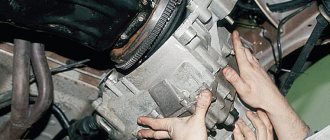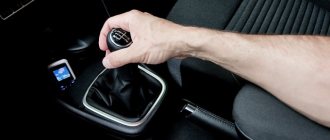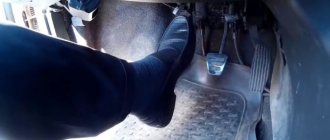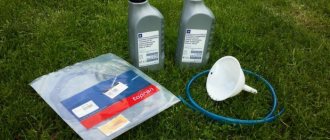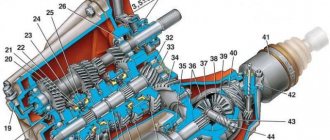The clutch in a car performs the function of transmitting torque from the engine to the gearbox. And not just transmissions, but with the ability to smoothly, with minimal jerks, “separate” the engine and transmission. Due to the workload and relatively complex design, the clutch often begins to work incorrectly or fails altogether.
Let's look at the reasons why the clutch disappears, and also consider some simple options for self-diagnosis of this problem.
For some reason the clutch began to not be fully depressed
Why is the clutch not fully depressed? Yesterday everything was fine, but today the gears are very difficult to engage, the rear one generally has a strong crunch. Today I pumped the slave cylinder, nothing helped(
And what kind of crap is screwed to the box from which a hose goes to the working cylinder and a hose comes from the upper cylinder with the barrels? On this crap, I recently broke off a fitting when I wanted to unscrew it.
Extend the rod that moves the fork, grind it out of a bolt of the same diameter but longer. Replacing the release valve worked for me, but for some it didn’t help.
Why did this happen? To be honest, I thought about adding a nut, but some kind of collective farm solution to the problem.
Maybe try adjusting the pedal? There is an adjustment on the pedal itself.
in fact, a common problem among subarists, I have not heard of a panacea.
I’m struggling with the same problem, I concluded that the reason is an under-pumped clutch, because to do it according to the manual, you need to remove the working cylinder with some kind of device, fix the piston so that it doesn’t spit it out and pump it, pointing the fitting up. Otherwise, there will still be air in the worker
Yes, I read this yesterday, I think that this is another manual nonsense))) just look, if there is air in the system, then when pumping up the clutch pedal it should compress and the gear should easily engage, but alas, this does not happen, maybe I’m wrong.
who else solved the problem?
If you think like this, then bleeding the clutch and brakes would not be necessary at all. Wait until the brake fluid comes out of the fitting and drive, but no, everyone knows perfectly well the difference between an unbleeded and a bleeded system. It’s just that the air is compressed very strongly, but the liquid is not
in general, pump up as it is written in the book?
Imagining the entire mechanics of the process, yes. Only I don’t know yet. how to fix the rod. I took a towing eye from a Honda SRV and tried to make a device out of it. In the itor, I screwed the loop to the cylinder, the rod just fit into the eye-bend of the loop, when I tried to pump this piece of iron 5mm thick. started to bend. As a result, due to the resulting lateral force, the mounting ear of the cylinder burst. Well, there was a spare one. While I’m thinking about what to make the device out of and I’m driving with not always full squeezing, I have to use anything up to and including re-gearing, so as not to torture the box
Teem
I pumped the working one by simply resting the rod against the box, there is no need to reinvent the wheel for this, there is not such pressure that everything will fly out of your hands, it’s just a little inconvenient and that’s all.
In general, I pumped it 2 days ago, everything is fine now! I did this: I removed the rod, removed the protective rubber band, unscrewed the fitting, pressed the cylinder with a screwdriver so that it went all the way out, then when all the air and all the old fluid came out, I twisted the fitting, shook the pedal so that the piston would come halfway out of the cylinder, I did this 3 once and everything is ok! no tools needed!
The problem with the slave cylinder is that the clutch slave cylinder is located at approximately 45 degrees relative to the horizontal plane of the ground and, as a result, is poorly pumped (air accumulates at the top, where the piston is, and not where the bleeder fitting is). The easiest way to bleed it is to unscrew the two bolts from the box body that hold it in place and hang it vertically on a hose so that it hangs with the stem down. Then you need to unscrew the bleeder fitting on it (don’t forget to add fluid to the tank) and push the piston all the way with a screwdriver, for example (only after completely unscrewing the fitting), then you need to wait 10 minutes without tightening the fitting so that a little liquid drains out and the air came out). Then all that remains is to tighten the fitting and put everything back.
Source
Methodology for driving a vehicle
Even with reverse gear engaged.
Handle forward and backward - directly under the chair; backrest tilt handle - left; • move the lever to the neutral position (it is impossible to check this - immediately after turning the key you can leave, unexpectedly); • you can release the clutch pedal (or you can [but not necessarily] not release it in order to facilitate the operation of the starter); • turn the key 180° clockwise: in this position, current flows to the spark plugs and ignition occurs while the engine is running; • key - to the starter, that is, turn it another 45 ° clockwise (keep pressed for no more than 2 seconds.)
The clutch pedal is pressed hard: causes and methods of combating
If the car is running manually, then there will definitely be a clutch pedal. Its main task is to disengage the moving mechanisms in the car to change gears and, accordingly, bring them together. Therefore, it is immediately clear that this element involved in management is very important. In practice, a problem may arise that is associated with the tightness of squeezing this pedal. And many warriors can notice such a problem almost immediately. However, because they do not know what to do about it and whether it is a big problem, it is necessary to understand this issue and solve it.
1. The mechanism itself has so-called petals that produce clutch. Therefore, the tightness may be due to the fact that they are slightly deformed;
2. Also, it should be noted that in the mechanism itself there are many links that interact with each other and as a result perform some action. One such mechanism that can lead to a stiff pedal is a bearing failure. As a result, it is necessary to use more pressing force so that the cable can perform its function;
3. If the second problem is not resolved in any way, a third reason for the clutch pedal’s stiffness may also arise - breakage of the cables due to heavy load.
When the reasons have been sorted out, it is necessary to talk directly about ways to solve this problem.
1. To begin with, it is worth saying that you need to contact the service center in order to find out the cause of this problem. After the service has announced this, you can follow the path of least resistance and simply replace the parts with new ones. Indeed, this option may not be entirely economical, but from a quality point of view it is suitable;
Clutch operation in different drive systems
Every driver knows that there are several types of transmission. At the moment, three are most often used in production:
- Mechanics. When you press the clutch pedal, the force is transmitted using a cable. It is in this system that it is easiest to burn a part. The cable is placed inside the casing. The housing is located in front of the pedal.
- Hydraulics. Structurally, this system consists of two cylinders. They are connected to each other by a tube that can withstand high pressure. When the driver presses the pedal, a rod with a piston at the end is activated. It creates pressure on the brake fluid, and it is transmitted to the working cylinder.
- Electrical system. In this case, the clutch has an electric motor. It is activated when you press the pedal. A cable is attached to it. The further process occurs by analogy with mechanics.
These are the three clutch systems that automobile manufacturers use in their cars. Knowing which one is installed on your car will help you avoid burning out the clutch.
Content
It would seem, what mistakes can be made when driving a manual? For example, many people start in second gear. – is this a critical error? On some cars - no, this will not lead to anything bad if you do not make strong gas changes. If the engine is not overloaded, the clutch pedal is used correctly and there is no slipping, then starting from the wrong speed will not harm the manual transmission, but the same cannot be said about the clutch mechanism. In this case, increased wear occurs upon contact between the driven and driving disks.
But there are not only occasional mistakes made by drivers due to inattention or inexperience, but also some bad habits, the consequences of which many do not even think about.
Additive for manual transmission (DSG) "Suprotek manual transmission"
Restores gears and synchronizer couplings in mechanical and robotic transmissions. Eliminates hum and vibration, facilitates gear shifting, and reduces fuel consumption.
About automatic transmission
There is no clutch as such in an automatic transmission. Here this role is assigned to the torque converter. It includes two turbines through which oil circulates under pressure. Because of this, the clutch on an automatic transmission is often called wet. That is, torque is transmitted through oil. But can the clutch burn out on an automatic? The signs of a malfunction in this case are different. So, the box will go into emergency mode, and the gears will kick into gear. All this indicates wear of the friction packs.
But jerking can also occur for other reasons (for example, due to solenoids or a clogged valve body). Therefore, in any case, the automatic transmission needs to be diagnosed in detail.
Mechanical Driver Mistakes
Keep your foot on the clutch pedal
Some car owners drive with the clutch pedal pressed, that is, if your foot is held in close proximity to the pedal, it still presses it a little.
Why can even small pressures be harmful? How correctly the foot is placed on the clutch pedal and gradually along the way the foot begins to lower slightly, and the driver, without thinking about it, presses it a little. The clutch begins to diverge a little and burn. At first you don’t feel it, but then after about 5000 km, changes in the clutch operation begin. And after 10 thousand kilometers or more, replacement will be required. Therefore, it is better to keep your foot separately, and not above the clutch.
Sudden start and slipping
A sharp start and tight driving by professional drivers, like in the movies, with careful gear shifting at the right moment will not harm the manual transmission.
But if fast driving enthusiasts act carelessly, crunching into gear while squeezing full throttle so that the car jerks, the unit will quickly require repair. Such actions wear out the clutch and destroy the gears inside the gearbox. Also, often the mistake of new and inexperienced drivers is an uncertain start, when the car is still standing, the clutch pedal is slowly released, the car is already shaking strongly, and when the discs touch, the smell of a burnt clutch appears in the car.
Clutch not fully depressed
Sometimes it happens that the gear changes without a clutch.
If you start to change gear before the pedal is fully pressed, a sound occurs that makes it clear: the car's manual transmission was in pain. If the clutch is not fully depressed, excessive load is applied to the unit: the gears meet in inappropriate planes and wear out each other. However, in general, you can start and change gears even without a clutch, if the driver feels the car perfectly. But many people do not have such experience, so it is recommended to depress the clutch pedal completely until it is in working condition and only then engage the gears so that there is no crunching. And if there is something wrong with the clutch, you should not try to drive without it, but call a tow truck. This will be even cheaper than repairing the gearbox after careless actions.
Incorrect engine braking
Many motorists use engine braking, for example, on long descents they switch to a lower gear, so as not to overheat the brakes. This technique is even taught. Engine braking itself is a very correct thing, but you just need to be able to do it.
However, when braking with the engine, do not forget that the car’s stop lights do not light up. This means that the car behind you does not receive signals that you are braking. This situation can lead to an accident, so it is better sometimes to apply the brakes a little to signal the cars behind you to stop using your brake lights.
A common mistake when braking with an engine is haste. That is, you cannot immediately engage the first one from the fourth speed. With proper engine braking, it is necessary to lower the gears gradually, at most every other gear, while reducing the speed. When some motorists think about using engine braking at 80 km/h, they immediately engage first or second gear. The manual transmission does not tolerate this very well; the transmission may even fall into pieces.
Noise when pressing the pedal
If the noise appears when the clutch is disengaged, then we can safely say that the damper springs on the clutch disc are worn out. Often the elements connecting the casing to the pressure plate also fail. Sometimes the noise is caused by the clutch fork.
The friction linings on the disk wear out on average within 100-150 thousand kilometers. However, this depends on the quality of the kit and the make and model of the car. As for replacement, they are guided by mileage. The clutch disc cannot be repaired and must be replaced entirely.
Why don't the gears turn on when the engine is running?
As for the problem of switching when the internal combustion engine is running, in the list of the most common faults we note:
- lack of gear oil in the gearbox;
- problems with the clutch mechanism;
Engine speed and duration.
Disadvantages of driving at low and high speeds. What engine speed is best for driving? Tips and tricks. A complete lack of lubrication in the gearbox will not allow you to change gears, since without oil the synchronizers will not be able to work normally and the gears will not engage in the gearbox.
It is mandatory to introduce only lubricant recommended in terms of viscosity and other characteristics.
In this case, the broadcasts will be turned on tightly or not at all.
If the level is low, it is necessary to check the tightness, repair defects and bleed the clutch.
After removing the box, it is necessary to inspect the basket for deformations, signs of overheating and other defects. If found, the element must be replaced.
Engine speed and duration.
Disadvantages of driving at low and high speeds.
What engine speed is best to use. Tips and tricks. The engine temperature does not increase, the internal combustion engine temperature needle drops on the fly. Because after turning on the stove the temperature drops.
Diagnostics and repair, consultations.
What to do if the car accelerates worse, does not pick up speed, or has failures during acceleration.
Why the engine does not pull, how to find the reason for the drop in power. Violation of the combustion process of the air-fuel mixture in the engine. Why does detonation occur: the main causes of this malfunction and the consequences for the internal combustion engine.
How to quickly start the engine with a dead battery. Features and benefits of using an autonomous starting charger.
Tips for choosing a booster. How to remove engine starter lock.
Check if the immobilizer has accidentally activated and how to disable it. Diagnosis of possible alarm malfunctions.


